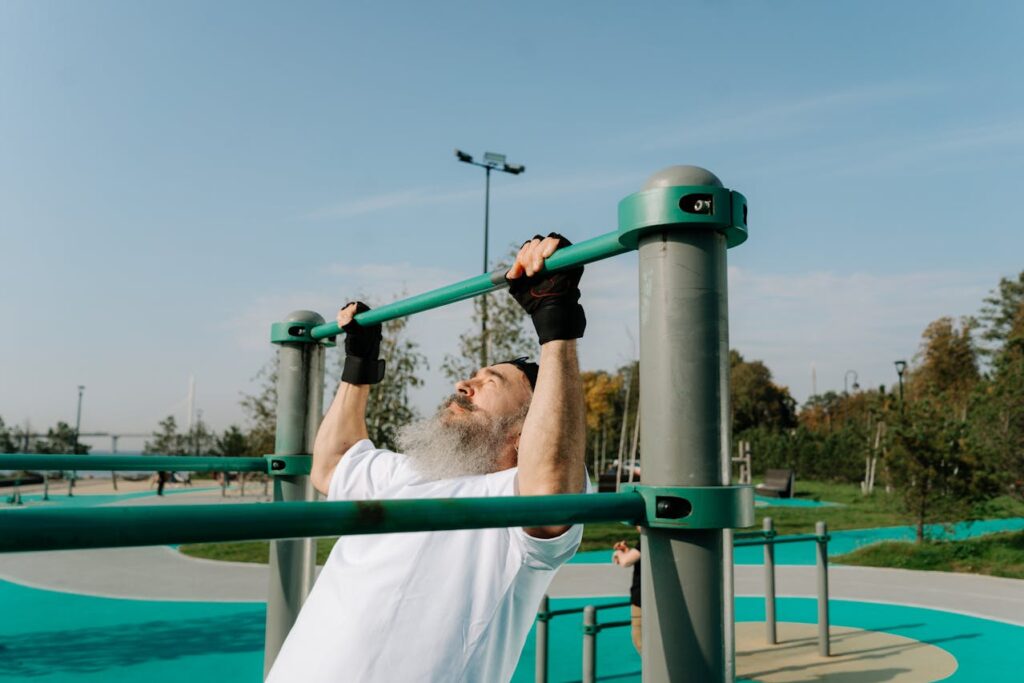 An Expert Framework for Strength Maintenance, Metabolic Health, and Longevity Through Protein Optimization
An Expert Framework for Strength Maintenance, Metabolic Health, and Longevity Through Protein Optimization
After the age of 30, adults lose 3% to 8% of their muscle mass per decade, accelerating after 60 years, according to the Journal of Cachexia, Sarcopenia and Muscle. By age 80, most people have lost more than 40% of their muscle mass, a condition known as sarcopenia. Yet, studies show that adequate and properly timed protein intake can preserve and even rebuild lean muscle tissue, even in older adults.
Research from the American Journal of Clinical Nutrition reveals that older adults who consume more than 1.2 grams of protein per kilogram of body weight per day experience 40% less muscle loss over time than those who meet only the Recommended Dietary Allowance (RDA) of 0.8 g/kg.
 Problem: Why Protein Becomes More Critical As You Age
Problem: Why Protein Becomes More Critical As You Age
For younger adults, protein supports performance and recovery. For aging populations, protein becomes a biological imperative for:
- Maintaining strength and independence
- Supporting metabolism and fat regulation
- Preventing falls, fractures, and hospitalizations
- Preserving immune response and hormonal balance
However, the standard RDA of protein (0.8 g/kg/day) is inadequate for older adults due to a phenomenon called anabolic resistance—a blunted response to protein consumption in the elderly. Without targeted nutrition, even physically active individuals over 50 can struggle to preserve lean tissue, leading to insulin resistance, frailty, and accelerated aging.

 What Science Says About Protein and Aging
What Science Says About Protein and Aging
Here are five high-impact findings that validate the connection between protein intake, muscle preservation, and healthy aging:
1. Muscle Loss and Mortality Risk
A study published in The Lancet found that loss of muscle strength (dynapenia) was a stronger predictor of all-cause mortality than body mass index (BMI) or fat percentage, particularly in adults over 65.
2. Higher Protein Intake Reduces Risk of Sarcopenia
A systematic review in Nutrients showed that protein intake above the RDA (1.2–1.6 g/kg/day) was associated with higher muscle mass, strength, and better physical performance in adults 50 and older.
3. Distribution Matters
Research from the University of Texas Medical Branch found that even protein distribution across meals (30g per meal) led to significantly more muscle protein synthesis compared to uneven intake (10g breakfast, 15g lunch, 65g dinner).
4. Leucine Threshold for Muscle Growth
Studies have demonstrated that 2.5–3g of leucine per meal is required to trigger maximal muscle protein synthesis in older adults—roughly equivalent to 30–40g of high-quality protein per serving.
5. Plant vs. Animal Protein
A meta-analysis in Advances in Nutrition revealed that animal-based proteins (especially dairy, whey, and eggs) provide superior muscle maintenance in aging due to higher bioavailability and leucine content. However, plant-based eaters can still meet needs with strategic combinations (e.g., legumes + grains + soy).
 The 5-Step Muscle Preservation Nutrition System
The 5-Step Muscle Preservation Nutrition System
To help to age adults (and proactive midlifers) maintain strength, performance, and independence, here’s the “5-Step Muscle Preservation Nutrition System”—an actionable framework rooted in current evidence.
Step 1: Set Your Protein Target (Days 1–2)
Goal: Calculate optimal protein intake based on body weight and age.
- Adults over 50: Aim for 1.2–1.6 g/kg/day (or 0.55–0.73 g/lb/day)
- For a 70-kg (154 lb (ca. 70 kg)) individual, this translates to 84–112g protein/day
- For those in strength training or recovering from injury: up to 2.0 g/kg/day
Tool: Use protein tracking apps like Cronometer or MyFitnessPal for accuracy.
Step 2: Distribute Protein Equally Across Meals (Days 3–7)
Goal: Avoid protein-skewed meals (light breakfast, protein-heavy dinner).
Optimal Strategy:
- 30–40g protein per meal, spaced across 3–4 meals/day
- This supports multiple spikes in muscle protein synthesis (MPS), critical for combating anabolic resistance
Example:
- Breakfast: 3 eggs + 1 Greek yogurt = 30g
- Lunch: Chicken breast salad = 35g
- Dinner: Grilled salmon + quinoa = 40g
Step 3: Prioritize Leucine-Rich Protein Sources (Week 2)
Goal: Hit the leucine threshold at each meal for optimal MPS.
Top Leucine-Dense Proteins (per 100g):
- Whey protein isolate: 3.2g
- Chicken breast: 1.7g
- Eggs: 1.1g per egg
- Lentils + quinoa combo: ~2.5g (with larger serving)
Practical Tip: Supplement with 5–10g of BCAAs (Branched-Chain Amino Acids) if dietary sources are insufficient, especially in plant-based diets.
Step 4: Time Protein Around Physical Activity (Week 3)
Goal: Amplify the synergy between exercise and protein intake.
Best Practices:
- Consume 25–40g protein within 1 hour post-workout
- For morning exercisers: Add a protein shake post-training
- Evening strength sessions: Ensure protein-rich dinner follows soon after
Why? Exercise sensitizes muscle tissue to amino acid uptake, maximizing recovery and hypertrophy.
Step 5: Enhance Muscle Retention with Resistance Training (Ongoing)
Goal: Pair protein intake with mechanical loading for optimal preservation.
- Frequency: Minimum 2x/week full-body strength sessions
- Progression: Increase resistance gradually (5–10% load increase every 2–3 weeks)
- Volume: 2–3 sets of 8–12 reps per major muscle group
Outcome: Combines anabolic nutrition with muscle stimulus, reversing age-related decline.

 30-Day Protein & Strength Optimization Plan
30-Day Protein & Strength Optimization Plan
| Week | Focus | Key Action |
|---|---|---|
| Week 1 | Audit and Align | Calculate protein needs, track current intake |
| Week 2 | Meal Balance | Redesign meal structure to distribute protein evenly |
| Week 3 | Source and Supplement | Upgrade protein sources, add leucine-rich items |
| Week 4 | Train & Time | Match strength training to protein windows |
Supplements (if needed):
- Whey or plant-based protein powder (1 scoop = 20–25g)
- Creatine monohydrate (5g/day): Supports lean mass in aging populations
- Vitamin D3 + Magnesium: Supports muscle contraction and protein utilization
 How to Track Progress and Success
How to Track Progress and Success
- Strength Metrics: Record reps/weights weekly in compound lifts (squat, deadlift, push-up)
- Body Composition: Use DEXA scan or bioelectrical impedance every 8–12 weeks
- Protein Intake: Daily tracking (goal: >1.2 g/kg consistently)
- Energy & Function: Track subjective energy levels, joint mobility, and recovery
- Gait Speed / Grip Strength (if 60+): Predictors of longevity
 Advanced Strategies for High-Performance Aging
Advanced Strategies for High-Performance Aging
1. Protein Pulse Feeding
- In older adults with muscle wasting, feeding small protein doses (15–20g) every 3 hours has shown superior MPS response compared to larger, less frequent meals.
2. Sleep-Protein Coupling
- Casein protein (slow-digesting) consumed 30 minutes before bed has shown to enhance overnight MPS, supporting muscle retention.
3. Intermittent Fasting Modifications
- Traditional IF (16:8) can be risky for older adults due to fewer meals.
- Solution: Maintain feeding window, but ensure protein density in each meal and extend post-workout feeding window.
 Personalization Guide: Tailoring by Age, Health, and Lifestyle
Personalization Guide: Tailoring by Age, Health, and Lifestyle
| Population | Strategy |
|---|---|
| 60+ Adults | Focus on digestion-friendly proteins (yogurt, fish, eggs), resistance bands for strength |
| Vegetarians | Combine grains + legumes (e.g., rice + lentils), add soy, seitan, or pea protein powder |
| Overweight Adults | Use protein to support satiety and fat loss; aim for 1.6 g/kg of ideal body weight |
| Active Adults (40–60) | Cycle protein around intense workouts; track recovery and soreness as feedback |
 Cross-Disciplinary Connections
Cross-Disciplinary Connections
- Sleep Optimization: Better protein intake improves serotonin and melatonin synthesis, enhancing sleep quality.
- Gut Health: Diverse protein sources (especially plant-based) feed microbial diversity when paired with fiber.
- Hormonal Health: Protein supports testosterone, IGF-1, and insulin regulation, all critical for muscle maintenance.
- Immune Function: Amino acids like glutamine support gut lining and antibody production.
 Take Control of Your Strength Span, Not Just Lifespan
Take Control of Your Strength Span, Not Just Lifespan
Muscle loss isn’t inevitable—it’s preventable. And protein is the first line of defense.
✅ Step 1: Calculate your protein needs today (1.2–1.6 g/kg/day)
✅ Step 2: Distribute evenly across all meals—don’t skip protein at breakfast
✅ Step 3: Pair with resistance training 2x/week to lock in muscle retention
✅ Step 4: Track intake and strength biweekly—progress is measurable
You’re not just eating to survive—you’re eating to thrive longer, stronger, and sharper.
Let me know if you’d like:
- A printable 7-day high-protein meal plan
- A beginner resistance training plan for 50+ adults
- A visual infographic of the “5-Step Muscle Preservation Nutrition System”





